The constellation of the northern sky, which the Sun passes through after the summer solstice from 21 June to 19 July, therefore rises high above the horizon in winter. The constellation's bright stars form an irregular rectangle between Cancer and Taurus. The pair of brightest stars that reach first sidereal magnitude are called Kastor and Pollux. They are quite different: the brighter and closer Pollux is a lonely orange giant, without guides or points of interest. Kastor is a little fainter, but is an impressive star system, and so is in turn one of the most interesting stars in the sky. The constellation is crossed by the winter Milky Way on its western edge, so it offers a wide variety of celestial objects: from emission and planetary nebulae and open clusters to binaries and variable stars. The most impressive of these are the large open cluster M35, which is the most beautiful of its kind in our winter sky after the Hyades and Pleiades, and the bright planetary nebula Eskimo. In the latter part of the constellation, outside the Milky Way, lie quite a number of faint galaxies. Great discoveries have been made in Gemini in the past. Near the star η Geminorum, William Herschel discovered Uranus, the first planet of the modern era, in 1781. Near the star δ Geminorum, Clyde Tombaugh found Pluto again in 1930.
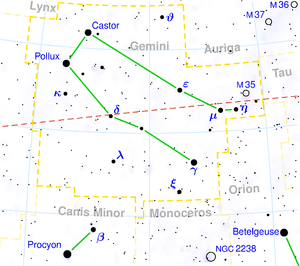
Pollux (β Gem) - With a brightness of 1.14 mag, it is the 17th brightest star in the sky. It surpasses the brightness of the Sun by a factor of 33, and its diameter is 9 times larger. Unlike Kastor, Pollux is orange-red and has a spectral class of K0. Its distinctive shade can be seen with the naked eye. It is located at a distance of 34 light years.
Kastor (α Gem) - Although Pollux is slightly brighter, the star designated as Kastor (the 23rd brightest star in the sky) is represented by the Greek letter alpha. It has a magnitude of 1.5 and is located 51 light-years away from Earth. In addition, it is known as a multiple star system. The primary component has a magnitude of 1.9 and is overall 22 times more luminous than the Sun, while the companion reaches a magnitude of 2.9. They orbit each other around a common center of gravity every 445 years. The angular separation of the pair has been relatively small in recent years, reaching a minimum of 1.9" in 1970. Since then, it has gradually increased, allowing these blue components to be resolved even with a small telescope. In 1985, their separation was 2.6", and by 2017, it had increased to 6".
Tejat Prior (η Gem) - Red giant, a bright semi-regular variable star with a magnitude change from 3.1 to 3.9 in a period of approximately 223 days. It has a companion with a magnitude of 8.8 at a distance of 1.4". A good comparison star is μ Gem. It is located at a distance of 700 light years.
Wasat (δ Gem) - A binary star distinguishable by a small telescope. The primary star has a magnitude of 3.5 and the companion has a magnitude of 8.2, with an orbital period of approximately 1,200 years. In 1985, the companion was 6" away from the primary star, making it observable with a telescope with a 6 cm objective diameter. By the year 2000, their mutual separation had decreased to 5.8". Even so, it is not a problem for a 200 mm telescope, in which we can also see their yellow or light blue color.
Mekbuda (ζ Gem) - One of the brightest Cepheids in the sky: the main yellow star changes its brightness in the range of 3.6mag to 4.1mag with a period of 10.15 days. Suitable comparison stars are κ (3.57mag) and υ Gem (4.07mag). One companion is located at a separation of 96" and has a brightness of 8mag, the second one is observed 87" away and has a brightness of 11mag. However, they are only optically companions. Mekbuda pulsates from a distance of 1120 light years.
38 Gem - The companions have a brightness of 4.7 mag and 7.7 mag and orbit each other once every approximately 3,190 years. At the turn of the century, their mutual separation was approximately 7.1", which can be comfortably separated by a telescope with an 8 cm objective diameter. One has a yellow color, the other has a light blue color.
R Gem - Variable star of the Mira Ceti type, its brightness varies in the range of 6-14mag with a period of 370 days. It is located near the star δ Gem.
M 35
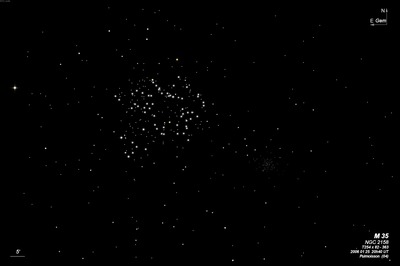
Phillippe De Chéseaux discovered M35 = NGC 2168 = h377 in 1745-46. John Bevis independently found the cluster before 1750 (possibly earlier than De Chéseaux). On 19 Feb 1827 (sweep 58) John Herschel described "a L, coarse, p rich cl of st 9...16m, which fills 2 or 3 fields, but cheifly one in which are about 100 stars."
200/250mm - 8" very bright string cluster, very large, excellent field but not rich in faint stars. Many of the stars are arrange in rows and loops.
400/500mm - 18" (11/14/09): gorgeous view at 75x, which beautifully frames the cluster as well as nearby NGC 2158. The densest portion is the central 25' where roughly 250-300 stars are resolved. The cluster is noticeably lopsided due to a loop of stars that juts out on the SE side of the cluster. This loop includes mag 7.5 HD 42086 near its SE end. The brightest cluster star is a double on the north side (O∑ 134 = 7.5/9.1 at 31") with a bright orange-colored primary. A prominent loop of stars heads south and curves to the west beginning at O∑ 134. This same chain nearly merges with another prominent chain of fainter stars that begins on the west side of the cluster and forms a string that heads east through the cluster. Other loops and chains caught my eye as star chains seem to outline regions where there are star voids. The cluster itself resides in a rich star field though is fairly well-detached by a region of lower star density surrounding the cluster, particularly around the south side.
Naked-eye - Visible as a fairly small naked-eye glow in a dark sky.
Notes by Steve Gottlieb
NGC 2392
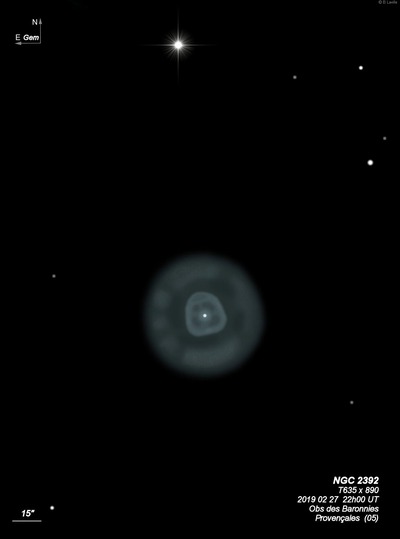
William Herschel discovered NGC 2392 = H IV-45 = h450 on 17 Jan 1787 (sweep 694) and recorded "a star with a pretty strong milky nebulosity equally dispersed all around. The star about 9m. Having but just began I suspected the glass to be covered with damp, or my eye not yet to be in order; however a star 10 or 11m just north of it was free from the same appearance. A very curious phenomenon; like my northern Planetary in its growing state." The next night he added "One of the most remarkable phenomena I ever have seen." In the 1814 PT paper he used this object as an example of an evident connection between an atmosphere and a star.
The annularity of NGC 2392 was discovered by George Johnstone Stoney, Lord Rosse's assistant, on 20 Feb 1849. Stoney's sketch (figure 15, plate XXXVIII in the 1850 PT paper) also shows a dark spot just to the right (west?) of the central star. William Lassell reported similar structure with his 24-inch in Jan 1853: "The nebulous star has its envelope evidently fainter on the preceding side. Its circular outline is almost wanting there. About half-way between the centre and circumference there is a narrow, concentric, dark ring, within which the nebula is brighter than the exterior portion." His sketch was published in his 1854 MRAS paper (figure 6) on observations from Malta.
Using an 18.2-inch silvered-glass reflector Henry Cooper Key reported, "the present appearance of this object, as seen in my instrument, is that of a bright, but somewhat nebulous star closely surrounded by a dark ring; this again by a luminous ring; then an interval much less luminous, and, finally, at some distance, an exterior luminous ring" (1867MNRAS..28....2A). Father Secchi also sketched the double ring structure with the 9.5" refractor in Rome around 1856 as well as Barnard with the 12-inch refractor at Lick Observatory on 10 Apr 1890. He reported "a condensed point or 2 in the preceding part [of the inner disc], then there seems to be a dark vacuity about this disc and then a fainter nebulous ring. It is a remarkable object."
The CGCG misidentifies CGCG 086-035 = PGC 21128 as NGC 2392. The nickname "Eskimo Nebula" dates back to at least 1962 in a paper by William Liller's titled "Expansions of Planetary Nebulae".
300/350mm - 13.1" (1/28/84): bright mag 9 central star surrounded by a double shell with a bright inner disk and a dark ring separates the two shells.
400/500mm - 17.5" (12/19/87): using 410x exhibits a prominent double shell structure with a very bright inner shell about 20" diameter with a darker central hole surrounding a very bright mag 9 central star. The Eskimo has a very high surface brightness with a bluish color and easily takes this magnification. The inner shell is surrounded by a thin dark ring about 2/3 of the way out from center and a faint, barely detached outer halo. Located 1.6' S of mag 8.3 SAO 79428.
900/1200mm - 48" (4/1/11): I just took a quick look at the Eskimo at 488x but the view of the double green shells was stunning. The inner, brilliant annulus is irregularly shaped, with an elongated bulge on the north side. The ring essentially splits into two sections at the north end (the inner "ring" is fainter) with a darker interior forming a small pouch within the ring. This feature could be considered the "chin" at the bottom of the Eskimo's "face" in the eyepiece view. The outer shell is irregularly lit and brighter along the southern rim.
Notes by Steve Gottlieb
NGC 2371
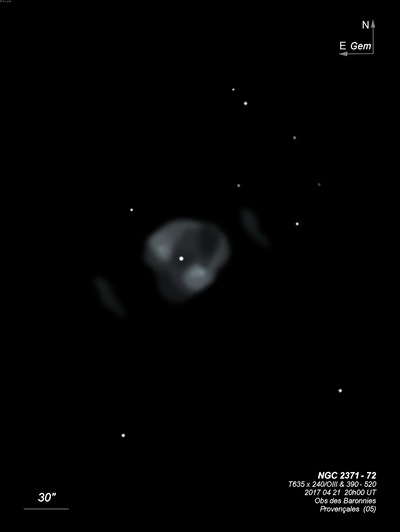
William Herschel discovered NGC 2372 = H II-317 = h445, along with NGC 2371, on 12 Mar 1785 (sweep 385). See NGC 2371 for his description.
300/350mm - 13" this is the fainter NE component of NGC 2371/NGC 2372. Slightly fainter and more diffuse than NGC 2371.
400/500mm - 17.5" see description for NGC 2371.
600/800mm - 24" (4/13/18): at 220x and NPB filter; the detached NW outer wing (1' from center) was faint but not difficult as an extended strip of nebulosity ~30"x10", oriented SSW-NNE. A mag 13.8 star is outside the wing to the west [1.5' from center]. The slightly fainter trailing wing required averted vision to glimpse, but is symmetrically placed 1' SE of center and well detached from the central bi-polar body.
900/1200mm - 48" (4/1/11): see description for NGC 2371.
Notes by Steve Gottlieb
NGC 2158
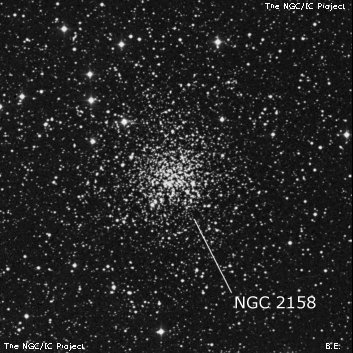
13x80mm (1/20/07): visible in the finder as a very faint, small glow about a half-degree SW of M35.
William Herschel discovered NGC 2158 = H VI-17 = h375 on 16 Nov 1784 (sweep 317), immediately after discovering NGC 2129. He logged "a very compressed cluster of vS stars, very rich." On 24 Feb 1827 (sweep 59), John Herschel described the cluster as "rich; much compressed almost to nebulosity; stars very small; irregular triangular figure."
NGC 2158 was classified as a globular by Rosino in 1954 (Contr. Padova in Asagio No. 52), Helen Sawyer Hogg, 1959 (Star Clusters) and more recently in the RNGC due to its richness. Nevertheless, it is considered an intermediate age open cluster (~ 1 billion years old). NGC 2158 is also five or six times as distant as M35, as far as 16,000 light years away (5071 parsecs).
200/250mm - 8" (11/5/83): few stars resolved over haze.
300/350mm - 13.1" (2/16/85): at least 20-25 stars resolved at 415x.
13.1" (11/5/83): ~15-20 stars, mottled clump near SE edge.
400/500mm - 17.5" (2/8/86): 30-35 stars resolved, unusually rich, compact, about 5' diameter. The appearance is similar to a resolved globular cluster. Located 30' SW of M35.
Notes by Steve Gottlieb
NGC 2266
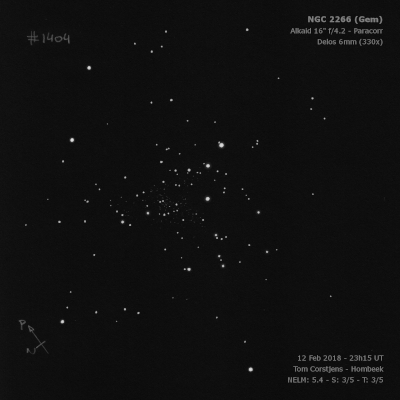
William Herschel discovered NGC 2266 = H VI-21 = h403 on 7 Dec 1785 (sweep 486) and recorded "a very rich and very compressed cluster of stars of about 4 1/2 or 5' diameter, 5 or 6 of the largest stars are in a row." His position is on the southeast side of the cluster. John Herschel noted his position from 24 Dec 1827 (sweep 115) was "the most condensed part of a p rich, p comp cl of stars 11...15m; irreg figure; diam of most compressed part = 3...4'' triangular."
300/350mm - 13.1" (12/22/84): three dozen stars mag 9-15 in a 4' diameter. Most members are very faint and the cluster appears quite rich with averted over unresolved background haze. The brightest star, mag 8.6 SAO 78670, is at the southwest edge of cluster and a string of five brighter stars mag 10-12 trail to the ENE. An isolated mag 10 star is off the northwest corner.
Notes by Steve Gottlieb
IC 443
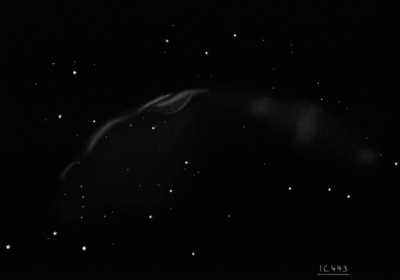
Max Wolf discovered IC 443, along with IC 444, on 25 Sep 1892 with a 2 1/4" lens. In AN 3130 (1892), he recorded finding "[Two] Very large and bright nebulous masses are visible there [near Mu and Eta Geminorum], which very roughly have their centers at approximately 6h 14m +24° IC 444] and 6h 08m +22° [IC 443]."
E.E. Barnard independently discovered these two nebulae in 1894. He reported in "Astronomy and Astro-Physics", Vol 8, No. 3, "On this same plate [taken on 1 Feb 1894 with a 2h 10m exposure] is a faint narrow curved nebulosity in about, 1860.0, 6h 8m + 23° 0'. It is nearly 1/2° long, extending north and south and convex to the east."
300/350mm - 13.1" (1/18/85): at 62x with filter, appears as a very faint elongated strip of nebulosity, perhaps 10' in length. Not visible without a filter.
400/500mm - 17.5" (1/16/02): at 64x and OIII filter, the most prominent section of this supernova remnant is a gently curving band of nebulosity oriented NW-SE, ~10'x3' with a well-defined edge along the eastern (bowed-out) boundary. A larger region of low surface brightness haze, ~20' in size, spreads out to the west of the northern end. At the SE end, the band dims and seems to hook to the SW towards a small arrowhead of stars. Located ~2.5 degrees SE of M35 and following mag 3.3 Eta Geminorum.
17.5" (1/20/90): at 82x with OIII filter this supernova remnant appears moderately bright, large, elongated 5:2 NW-SE. Appears a bit larger and brighter at the NW end. Much fainter nebulosity is close south off the west end and a couple of mag 10 stars are superimposed. Surprisingly easy to view with an OIII filter.
Notes by Steve Gottlieb
NGC 2129
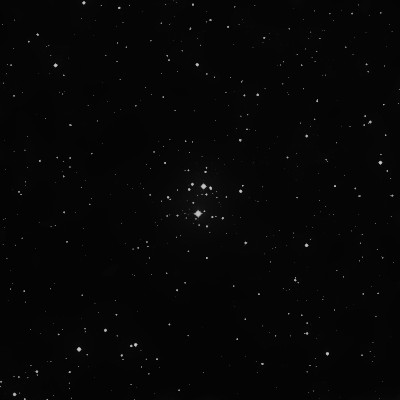
This group is apparently an asterism based on a 1994 study.
William Herschel discovered NGC 2129 = H VIII-26 = h372 on 16 Nov 1784 (sweep 317) and described "A Cl of st of various magnitudes, not very rich, 6 or 7' diam." On 24 Feb 1827(sweep 59), John Herschel wrote, "about 40 or 50 st. The brightest 8m taken. The rest are 10...15m." The center (as defined as the midpoint of the two mag 7.5-8 stars) is 06 01 07 +23 19.4 (J2000).
By analyzing William Herschel's early "reviews" of bright stars (before his systematic sweeps), which resulted in the discovery of many double stars, Wolfgang Steinicke recently found (email Oct '16) that Herschel first discovered the cluster on 6 Feb 1782 using his 6.2" reflector.
400/500mm - 17.5" (12/20/95): bright, fairly rich group surrounding two mag 7.5 and 8 stars (SAO 77842 and 77839) oriented N-S. There are about three dozen stars mag 10-14 in an 5' well-detached circular group with several double stars including a faint pair preceding the northern mag 8 star. The southern mag 8 star has a couple of very faint companions.
Notes by Steve Gottlieb
NGC 2395
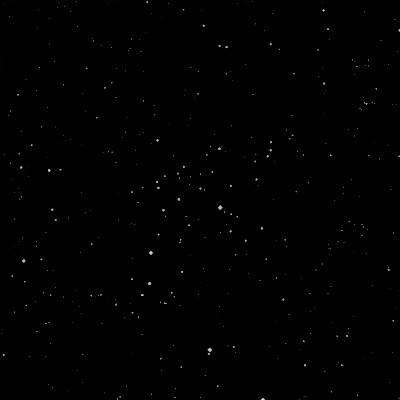
William Herschel discovered NGC 2395 = H VIII-11 on 16 Mar 1784 (sweep 176) and noted "a cluster of scattered stars." There is nothing at the Caroline's reduced position (or the GC/NGC position), but 30' southwest is this scattered group of stars. Auwers' reduced position is 1° too far south, so he made a reduction error. Still, this is an unusually large error, though the cluster was found only 3 months after WH began his sweeps and his positions are sometimes off quite a bit in his early sweeps. Caroline Herschel also noted a confusion in the sweep record about the offset star -- whether it was 50 or 51 Geminorum, so perhaps there is still an error to be uncovered.
300/350mm - 13.1" (12/22/84): scattered cluster of roughly 50 stars mag 10 and fainter in 15' field, not rich. Visible faintly in the 16x80mm finder. The planetary "Medusa Nebula" (Abell 21) lies 34' SE.
Notes by Steve Gottlieb
UGC 3573
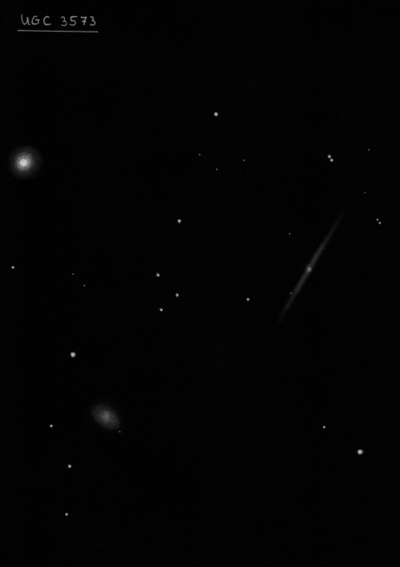
600/800mm - 24" (2/24/20): initially I noticed a slightly fuzzy mag 14.5-15 star, but with averted vision very thin low surface brightness "wings" extended NW-SE, ~30"x6". On the SDSS, the nucleus is perfectly stellar and identified as a star. CGCG 145-017 is 3.5' SE. A number of bright stars are near including mag 9.3 HD 265091 4.7' NE.
Notes by Steve Gottlieb
NGC 2420
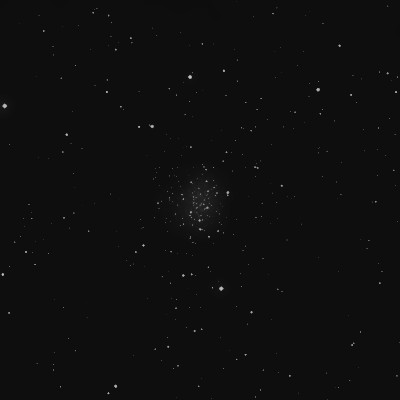
William Herschel discovered NGC 2420 = H VI-1 = h458 on 19 Nov 1783 (very early sweep and 4th object discovered) and recorded "a beautiful cluster of many large and compressed small stars, about 12' diameter." On 10 Feb 1787 (sweep 697) he noted "A brilliant rich cluster of stars." On 24 Feb 1827 (sweep 59), John Herschel called it "a p rich cl; irreg fig; 50...100 stars; 11...18m; 5..7' diam."
400/500mm - 17.5" (1/23/93): excellent cluster of at least 50 stars mag 11-15 within a 6' diameter. Good spread of magnitudes, includes 15 stars mag 11-13 over a rich background of numerous mag 14-15 stars and unresolved haze. The brightest mag 10 star is on the west side and has a mag 13 companion 12" S. Located between mag 9.1 SAO 79575 6' NNE and mag 8.9 SAO 79563 6' SSW. A faint galaxy pair, CGCG 117-059 and CGCG 117-060 (separation is just 40"), is in the field 10' WNW! Both of these are extremely faint and small.
Notes by Steve Gottlieb
NGC 2331
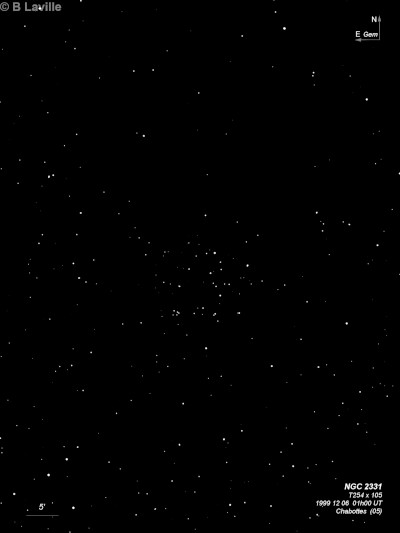
William Herschel discovered NGC 2331 = H VIII-40 = h432 on 11 Mar 1785 (sweep 384) and recorded "some clustering, large scattered stars; many of an equal size." John Herschel noted in on 17 Feb 1827 (sweep 57) as "a small cluster of 10 or a doze st 11...13m in an ellipse."
400/500mm - 17.5" (1/20/90): at 82x, very large scattered group of about 40 stars mag 10-14, 15' diameter. There is a small circle of 6 stars at the east end. The classification of this group as a true cluster is doubtful.
Notes by Steve Gottlieb
NGC 2355
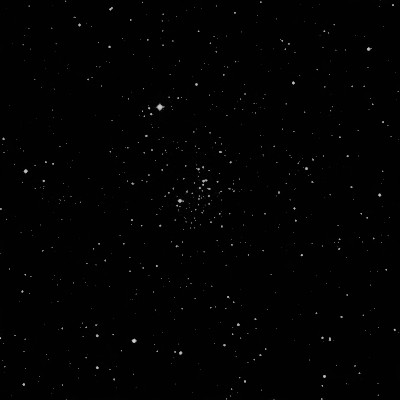
William Herschel discovered NGC 2356 = H VII-6 on 16 Mar 1784 (sweep 176) and described "A pretty rich and compressed cluster of stars." There is nothing at his position (reduced using the offsets given in Dreyer's 1912 "Scientific Papers of WH) but ~15' S is NGC 2355 and Harold Corwin concludes this number is probably a duplicate observation of NGC 2355. His position for NGC 2355 is not good either -- it's 100 tsec of RA too far west!
Based on photographic plates taken at the Heidelberg Obseratory, Reinmuth adds "no Cl north of NGC 2355, in 7h 8m.0 +14d 13' (1860) a loose clustering of st 11... in triangle." At Reinmuth's position (about 1 tmin preceding the NGC position) is a triangular group which stands out pretty well. But NGC 2355 is the best fit for NGC 2356. RNGC classifies the number as nonexistent.
300/350mm - 13.1" (1/18/85): about 50 stars down to mag 14 in a 8'x5' group elongated N-S including a mag 10 star at the SE edge. Rich, fairly compact, a number of stars are arranged in lanes. Located about 7' SW of mag 8.0 SAO 95722.
400/500mm - 18" (2/23/06): there is no cluster at William Herschel's position or nearby group of stars that match his description "A pretty rich and compressed cluster of stars" other than NGC 2355 10' S of his position. Corwin equates NGC 2356 = NGC 2355 (see description for NGC 2355). Also about 20' W of Herschel's position are 15 stars in a 3' arrowhead outline. This asterism is well detached in the field and though not impressive is also a possible candidate. A nice equilateral triangle of mag 11.5-12.5 stars with sides of 1' form the eastern corner of the group.
Notes by Steve Gottlieb
NGC 2339
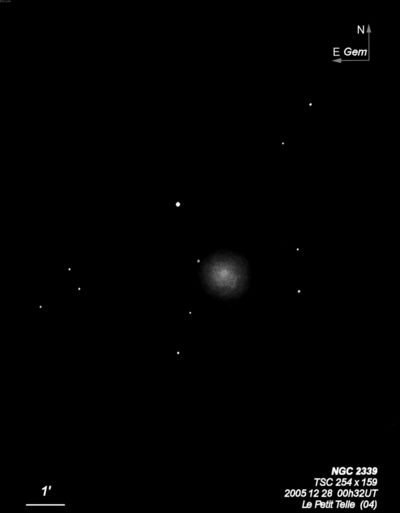
William Herschel discovered NGC 2339 = H II-769 = h434 on 22 Feb 1789 (sweep 906) and recorded it as "pB, pL, iR, easily resolvable, bM.". His position is 16 sec of RA east of UGC 3693. On 14 Mar 1831(sweep 333), John Herschel wrote, "pB, pL, R, glbM, 40". In a rich part of the heavens." and measured an accurate position.
300/350mm - 13.1" (1/18/85): fairly faint, nearly round, very weak concentration, low surface brightness. A mag 13.5 star is superimposed at the east edge 30" from center.
Notes by Steve Gottlieb
NGC 2274
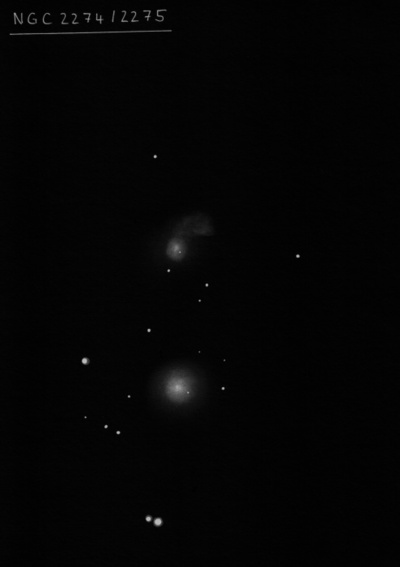
William Herschel discovered NGC 2274 = H II-614 = h406, along with NGC 2275, on 26 Oct 1786 (sweep 628) and described both as "Two, both F, S, R, bM. The southern one [NGC 2274] is the largest." The pair was observed a total of 14 times at Birr Castle! Harold Corwin notes the identifications of NGC 2274 and NGC 2275 are reversed in the MCG.
400/500mm - 17.5" (1/19/91): fairly faint, fairly small, round, small bright core. Forms the brighter of a pair with NGC 2275 2' N.
600/800mm - 24" (1/4/14): moderately bright to fairly bright, moderately large, slightly elongated N-S, sharply concentrated with a round high surface brightness core of 0.4' diameter that gradually increases to the center. Halo increases with averted to 0.9'x0.7'. Brighter of a close pair with NGC 2275 1.9' N. The pair resides in a rich star field with UGC 3537 7.4' NW. This low even surface brightness galaxy appeared very faint, fairly small, round, 24", no concentratin.
Notes by Steve Gottlieb
NGC 2291
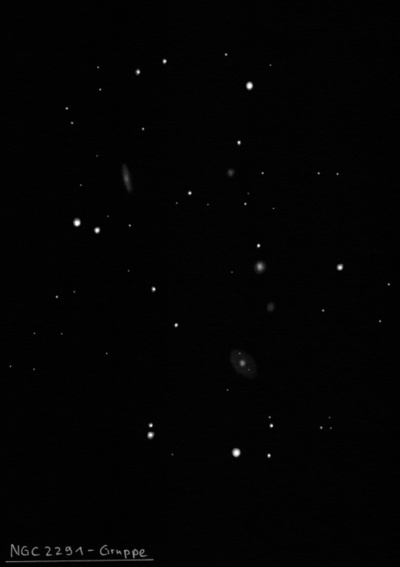
George Johnstone Stoney discovered NGC 2291 on 22 Feb 1849 using Lord Rosse's 72", noting "5 neb. in one field [with NGC 2288, 2289, 2290 and 2294]. It was labeled Delta on the field sketch. Dreyer assumed this nebula was JH's h409 (described as "eF; the northern of two, 3 or 4' apart") and possibly WH's III-897, but the Herschel designations more likely apply to NGC 2289. The positions of all 5 galaxies (computed by Dreyer and repeated in the GC and NGC) are offset 4' too far south and 8-9 seconds of time too far west. Hermann Kobold measured accurate positions in 1898 at Strasbourg.
400/500mm - 17.5" (12/19/87): very faint, small, slightly elongated, even surface brightness. Fourth of five in a group. On a line with NGC 2288 4.0' SSW and NGC 2289 3.0' SSW. NGC 2294 lies 2.6' ENE.
Notes by Steve Gottlieb
NGC 2341
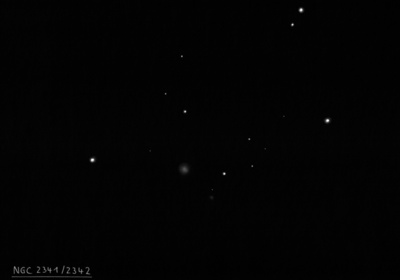
Albert Marth discovered NGC 2341 = m 100 (along with NGC 2342 = m 101) on 10 Nov 1864 with Lassell's 48" on Malta. His position matches UGC 3708 = PGC 20259.
400/500mm - 17.5" (1/20/90): faint, very small, slightly elongated E-W. A mag 13.5 star is 0.7' N. Forms a pair with NGC 2342 2.5' NNE.
Notes by Steve Gottlieb
IC 2157
Rev. Thomas Espin discovered IC 2157, along with IC 2156, visually on 11 Jan 1899 with his 17.3-inch reflector at his private observatory in Durham, England.
400/500mm - 17.5" (3/8/97): at 220x, ~30 stars are visible in a 6' group, including a half-dozen brighter mag 10.5-12 stars. The densest portion is ~4' diameter tapering to the NW and appears fairly rich with averted (over resolved haze). The east end of group is formed by a 5' arc of mag 10-12 stars concave to the NW. Forms a pair with the IC 2156 group 6' N (possibly part of IC 2157). Located ~35' W of NGC 2158 (off the SE side of M35).
Notes by Steve Gottlieb
Abell 21
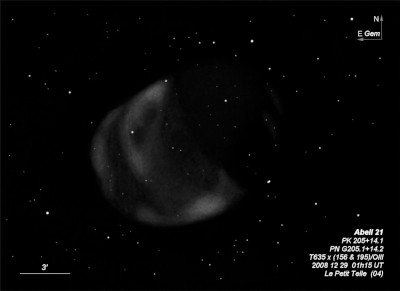
| Type | PN |
| RA | 07:29:02.7 |
| Dec | +13:14:49.0 |
| major_axis | 12.0' |
| minor_axis | 9.0' |
| mag | 11.3 |
| surface_bright | 15.5 |
M 1-7
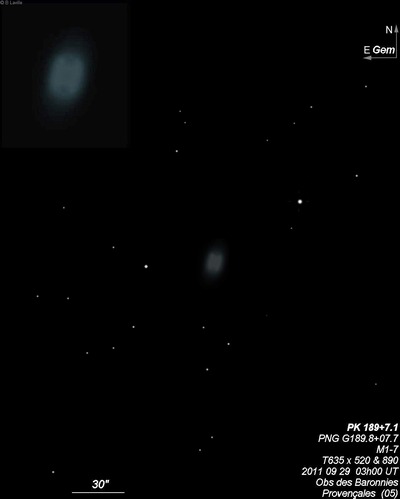
| Type | PN |
| RA | 06:37:21.0 |
| Dec | +24:00:37.0 |
| major_axis | 36.0'' |
| minor_axis | 18.0'' |
| position_angle | 3.0 |
| mag | 13.0 |
| surface_bright | 11.0 |
Abell 19
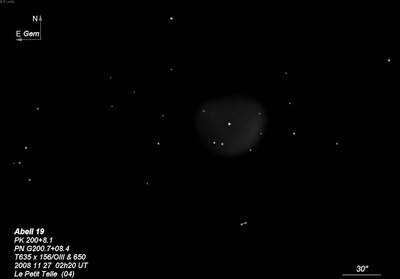
| Type | PN [2b] |
| RA | 06:59:56.4 |
| Dec | +14:36:34.0 |
| major_axis | 72.0'' |
| minor_axis | 60.0'' |
| mag | 17.0 |
| surface_bright | 16.9 |